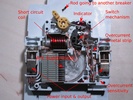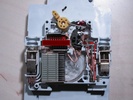This weekend, a main three-phase circuit breaker gave out. We tripped it with a short circuit on an old drill, and were unable to turn it on. I had it replaced (it’s illegal to do it by myself) and opened it, just to see what exactly failed and what’s inside anyway. When I was at it, I illustrated a few photographs to show how different modes work.
How they work
As you’d expect, there is a switch inside, that can be manipulated by the lever from outside, one wire goes in, one wire out. This holds for single-phase, three-phase breaker is composed of three single-phase joined together, with levers joined into one AND the mechanisms mechanically linked with a short shaft.
The switch by itself is combined of two parts. The lever directly manipulates metal hook, that pulls on the black plastic part, which in turn moves the actual contact. This is done so that if there is a short circuit (or overcurrent), the breaker trips even if you’re holding the lever up (so no, you can’t tape the breaker in the ON position :-)).
The breaker can be operated by several means. Besides manually, it can be turned off by another breaker (only in three-phase breakers). You might expect this is one due to the switches being joined together (often with a metal shaft), but this is not the case, as it might not be that reliable.
There is small shaft linking the breakers, going into the black plastic part, into the circular hole. In case one switch goes down, this shaft immediately pulls down the others. The force required to do this is much lower than on the manual lever, but I guess the main reason is that it can’t be influenced by the human holding the lever in the ON position (in case you’re switching on the breaker and one of the phase has short-circuit, all of them go down).
More interesting is how the actual function is performed:
Short-circuit
There is a coil, which when short-circuit current flows through it, pulls out a metallic core outside, and turns off the switch. This is the quick action for a huge currents, when you don’t want to wait for the overcurrent protection to kick in.
Over-current
A bimetal strip heats up as the current rises, and it bends, eventually pulling the metal rod, joining the strip and, again, the black part of the switch. This is the slow action, and required too large current to be present for some time before breaking the circuit. The sensitivity can be adjusted by a small screw, that is pretensions the bimetal strip (although this is not always present in cheap household breakers).
Arc suppressor
The last functional piece is the arc suppressor. An electric arc is formed when the switch is turned on or off, and needs to be extinguished to limit the damage to the switch contacts. As the arc forms, it travels down to the grill-looking part, and eventually fades along the way, when the AC passes through zero. Some higher voltage breakers would enclose the switch mechanism in a vacuum or inert gas, but not the regular distribution grid ones.
How they fail
The breakers fail rarely, as the trip-count they can survive is in the thousands, and if the arc suppression is designed adequately, it should survive a lifetime. More common problem is with a breaker that is operated for long periods at the designed current, and occasionally trips. This result in a high temperature inside the breaker and can negatively affect the components.
I don’t think either of these problems occurred in my breaker, although the temperature might have been a factor here. It seems that in mine, only the spring that tensions the black part of the switch, to be able to join with the manual lever, is worn out. If I tension it manually, the switch works just fine. Neither me, the electrician who replaced the breaker, of anyone else whom I asked never heard of this kind of failure.

